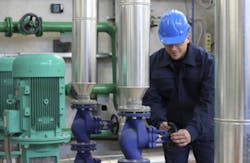RELATED: Read Part I in the "Troubleshooting Operational Issues" Series
RELATED: Read Part II in the "Troubleshooting Operational Issues" Series
RELATED: Read Part III in the "Troubleshooting Operational Issues" Series
RELATED: Read Part IV in the "Troubleshooting Operational Issues" SeriesRELATED: Read Part V in the "Troubleshooting Operational Issues" Series
RELATED: Read Part VI in the "Troubleshooting Operational Issues" Series
RELATED: Read Part VII in the "Troubleshooting Operational Issues" Series
The following article is the latest in a series based on the troubleshooting of a mysterious unit shutdown due to flowmeter performance problems.
For the last few months, I worked my way upstream from a liquid ammonia measurement problem to the pipeline to the ammonia tank farm and discovered that a pressure control valve at the ammonia tank farm exit was likely causing bubbles to form in warm weather and travel downstream where the bubbles affected the liquid ammonia ultrasonic flowmeter.
From what I could tell, the self-contained differential-pressure valve was intended to limit the ammonia pressure rise across the pump, while the local pressure-control loop at the tank farm exit was intended to limit the ammonia pressure in the ammonia distribution system.
After some thought, it was decided to modify the control strategy of the self-contained pressure valve such that it limited the ammonia pressure leaving the tank farm. This involved changing a few internal parts (diaphragms) in the self-contained pressure valve so that it regulated backpressure instead of differential pressure. The self-contained pressure valve body itself remained in place to bypass ammonia from the pump discharge back into the tank.
Making this change eliminated the need for the local pressure-control loop because the self-contained backpressure valve would limit the ammonia pressure to the plant. Further, modifying the self-contained valve and eliminating the pressure control valve allowed liquid ammonia to be discharged directly from the pump to the plant without introducing any restrictions that could create bubbles in the ammonia piping to the plant.
This sounds promising, but there are still some minor concerns to address. More next month…
RELATED: Read Part IX in the "Troubleshooting Operational Isssues" SeriesRELATED: Read Part X in the "Troubleshooting Operational Isssues" Series
David W. Spitzer is a regular contributor to Flow Control magazine and a principal in Spitzer and Boyes, LLC, offering engineering, seminars, strategic marketing consulting, distribution consulting, and expert witness services for manufacturing and automation companies. Mr. Spitzer has more than 35 years of experience. He can be reached at 845 623-1830 or www.spitzerandboyes.com. Click on the “Products” tab to find his Consumer Guides to various flow and level measurement technologies.Mr. Spitzer can be reached at 845 623-1830 or www.spitzerandboyes.com. Click on the “Products” tab to find his “Consumer Guides” to various flow and level measurement technologies.




